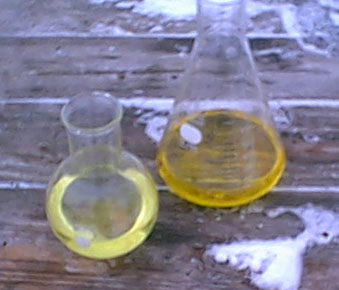
December 4, 2004

Organic carbonates are interesting molecules, however they are currently quite expensive to purchase so working with them has been prohibitive in a monetary fashion. However after coming across a synthesis for the preparation of ethylene carbonate, from which other organic carbonates could be made, that did not require the use of dangerous phosgene I decided to give it a shot. The following reaction was used:
HOCH2CH2OH + NH2CONH2 --(ZnO)--> (-OCH2CH2OCO-) + 2NH3
I followed the instructions given in patent EP0638541 with the exceptions that (1) I didn't use a reflux column and (2) My vacuum source was not as strong as recommended. The reactants were mixed in a 500 ml 1 neck RB flask and heated in a mineral oil bath with magnetic stirring. A thermometer adaptor was fitted with a glass tube to allow the vacuum to be hooked up to the flask and the connection was lubricated with vacuum grease. The mixture was held at 135 - 155C throughout most of the reaction and ammonia gas came over constantly which I scrubbed after the compressor by passing through moderately concentrated H2SO4. After holding the mixture at the reaction temperature for over 2 hours I allowed it to cool and weighed it, it had only lost enough weight to account for a 60% reaction though based on ammonia, if I would have either let this have a longer reaction time or had a better vacuum I believe I would have gotten better results.
I have yet to purify what I have, it can be converted to methyl carbonate or ethyl carbonate by refluxing with the appropriate alcohol. The products will have to be separated by distillation and if I attempt to distill the ethylene carbonate I will have to deal with the somewhat prohibitively high boiling point of near 250C, also diethylene glycol is an impurity in the original ethylene glycol stock and it has a boiling point within 5C of the boiling point of the ethylene carbonate so it would be impossible to separate that component from my product by distillation.
December 28, 2004

Yeah, the picture is blurry. Regardless, the flask on the left contains unadulterated sodium hypochlorite straight from the container it was purchased in, the container on the right contains the same hypochlorite after it was allowed to dissolve a somewhat large quantity of sodium bromide. The purpose being the preparation of the hypobromite anion, previously I knew that the order of reactivity of the halogens was reversed when it came to their oxoacids, the elemental bromine added to a solution of chloric acid would result in the liberation of free chlorine and the production of bromic acid in the solution. However I didn't think the reaction would carry over to the bromide anion reacting with the hypochlorite anion, but recent readings suggested that it may occur and as such I decided to give it a shot, as the picture shows there was definitely a reaction.
The resulting solution was mixed with a less then stoichiometric amount of acetone and allowed to react for 25 minutes. The induction period that is normally a minute or three at this temperature (That's snow on the ground and the reagents were stored outside so everything was nice and cold.) but with the hypobromite it started reacting immediately. I set the flask in the snow while it reacted. After the reaction was complete I was left with the normal milky white solution with a blob of what could be bromoform at the bottom. I poured off the excess and took a graduated cylinder that had some chloroform in it from a previous run and added the bomoform to it, it instantly cut straight through the chloroform and went straight to the bottom, not surprising considering bromoform is close to twice as dense as chloroform (See picture below). It appears to have been a success, later on distillation may give a better picture considering the great difference in boiling points.

I want to investigate the preparation of tetrahalomethanes from trihalomethanes and hypohalites. To do this I intend to take a known volume of chloroform, relatively pure, distilled and washed and previously weighed and the volume measured exactly. Then put it in a flask with concentrated hypohalite with magnetic stirring for a few hours and then measure the change in volume and mass, there should be a definite difference if the reaction was significant, plus tetrahalo derivatives are even less soluble then the trihaloderivatives, regardless it should be easy to tell if the hypohalite is doing its job.